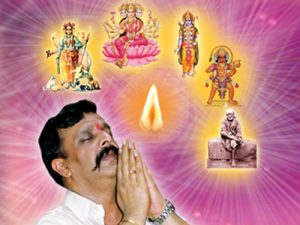
Sadguru Shree Aniruddha gives a brief description of his Five Gurus in the sacred work, the Shreemad Purushartha Grantharaj (Volume Two, Prempravas) authored by him.
SHREE GURUDATTA
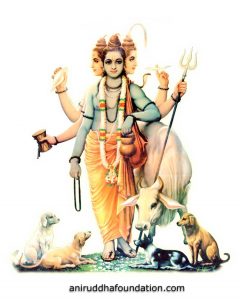
The Chetantattva, which is Svayamsiddha (equipped with matchless capacities and powers and so self-sufficient) and Svayamprakashi (self-illumined), is itself the Parameshwar. Shraddhavans call it ‘Dattaguru’.
Dattaguru, the first among the Panchagurus (Five Gurus), is the Master Enabler, the Lord and Master of the Sadguru Shree Aniruddha’s Anandamaya Kosha (The innermost of the five Koshas, i.e. layer or sheath, it refers to the causal or blissful body). Referring to the following verse from the Sai Satcharita, Sadguru Shree Aniruddha illustrates the significance of Dattaguru.
दत्तासारिखे पूज्य दैवत । असता सहज मार्गी तिष्ठत।
अभागी जो दर्शनवर्जित । मी काय पावत तयासी॥
(If you decide to skip the Darshan of the most revered and adorable deity like Shree Datta, Who stands waiting for you, that too right on your path, you are truly unfortunate. And in such a situation, how do you expect that I grace you?)
The above verse reveals the course of Sadguru Shree Aniruddha’s mission, as also his unshakable faith and commitment at the Feet of Shree Gurudatta.
SHREE GAYATRIMATA
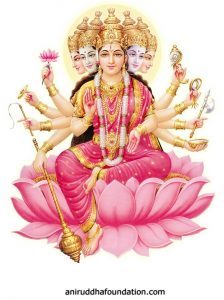 ‘Gayatri’, the very first, the foremost manifestation of the supremely pure, sacred and auspicious Aadimata is active at all times only at the causal level.
‘Gayatri’, the very first, the foremost manifestation of the supremely pure, sacred and auspicious Aadimata is active at all times only at the causal level.
‘Gayatri Mata’ is Sadguru Shree Aniruddha’s Vaatsalya Guru. She governs his Vidnyaanamaya Kosha (one of the five sheaths of the Deha) and is His second Guru.
The awareness that ‘I am the Parameshwar’ of the Parabrahma is indeed the Parameshwari or the Aadimata whom the Vedas refer to as ‘Gayatri Mata’. It is by the grace of the Gayatri form alone that man is able to attain knowledge in any field or discipline, whatsoever, and even implement it or put it to use.
SHREE RAMA
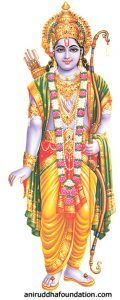 Prabhu Shreeram is Sadguru Shree Aniruddha’s Kartaa Guru (the Doer Guru). He is the Lord and Master of Shree Aniruddha’s Manomaya Kosha. The character, personality and values of Shreeram are the actual examples of the implementation of the principles of Maryada (healthy limits).
Prabhu Shreeram is Sadguru Shree Aniruddha’s Kartaa Guru (the Doer Guru). He is the Lord and Master of Shree Aniruddha’s Manomaya Kosha. The character, personality and values of Shreeram are the actual examples of the implementation of the principles of Maryada (healthy limits).
Shreeram is referred to as the Maryada Purushottam (the best among men and the one Who adheres to the value of restrain at all costs).
MAHAPRANA SHREE HANUMANTA
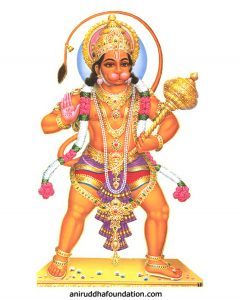
Shree Hanumanta, the fourth Guru of Sadguru Shree Aniruddha, is his ‘Rakshak Guru’ (the Protector Guru). Shree Hanumanta is, in fact, the matchless ‘Maryada Rakshaka‘ (He values Maryada, abides by it and protects it).
Shree Hanumanta, the Lord and Master of Sadguru Shree Aniruddha’s Pranamaya Kosha and his Protector Guru, who finds fulfilment and happiness in calling Himself the Server of Prabhuramachandra, and Bapu, ascertains with pride that his mission and life task find fulfilment in humbling himself before and serving this Server.
The unique Shree Hanumanta, the One and only who accomplishes the journey from the limited to the boundless, from Bhakta to divinity.
SAI SAMARTHA
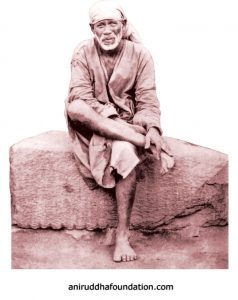
Shree Sai, the fifth Guru of Sadguru Shree Aniruddha, is his Digdarshak Guru (the Guru who Guides), the Lord and Master of his Annamaya Kosha (the outermost of the five Koshas (layer or sheath), refers to the physical body which needs food and nourishment to thrive.)
Sadguru Shree Aniruddha has spoken about Shree Sai in discourses based specially on the Shree Sai Sachcharit which is an account of life and times of Shree Sai on the one hand and guidelines for progress and happiness in the worldly life of Bhaktas on the other. The discourses are Sadguru Shree Aniruddha’s unique expression of love for his Digdarshak Guru as well as for the Shraddhavans.
Referring to the Shree Sai Sachcharit in which several verses express the modesty, humility, unpretentiousness and the great unassuming manners of Shree Sai, Bapu says in “Prempravas” Volume Two of the Shreemad Purushartha Grantharaj, “If Saisamartha, the Master of my Annamaya Kosha, my Guru, who guides and directs, pronounces the above words, I assert that I have no right to talk about my immensity or prominence”.
